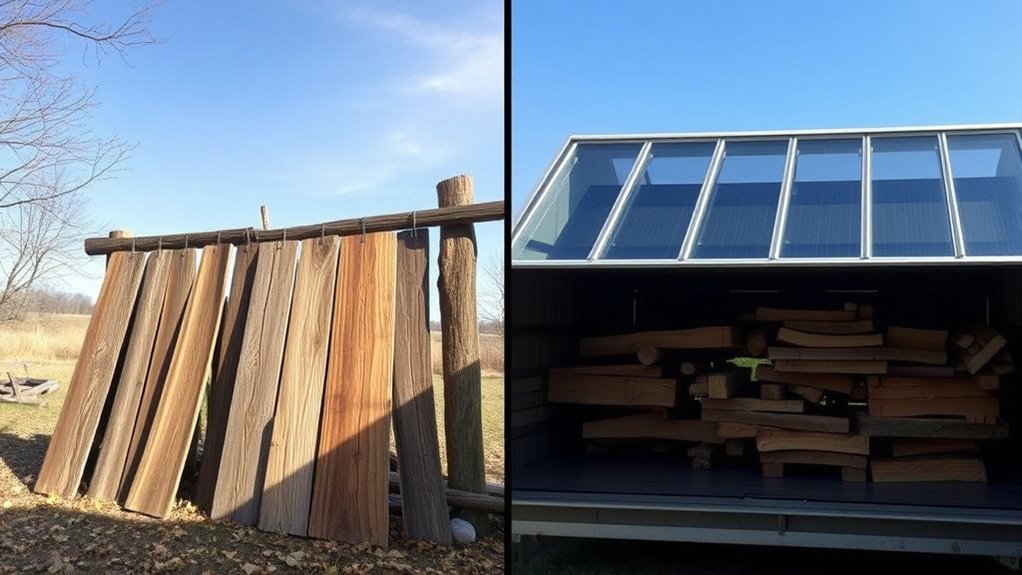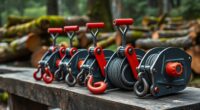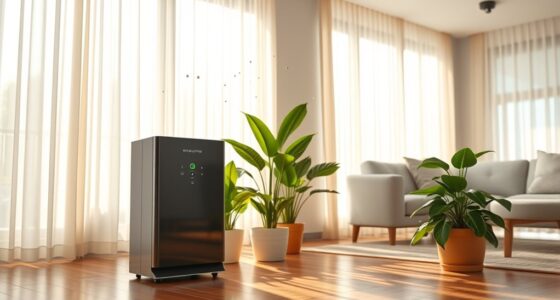If you’re choosing between air-drying and a solar kiln, consider your budget, timeline, and quality needs. Air-drying is inexpensive and natural but takes months or more, depending on climate. Solar kilns cost more upfront but dry wood faster and more evenly, reducing defects. Both methods work well for different projects, but a solar kiln offers better control and efficiency. To discover which method suits you best, explore the details below.
Key Takeaways
- Air-drying is low-cost and eco-friendly, relying solely on natural environmental conditions, while solar kilns require higher initial investment but speed up drying.
- Solar kilns significantly reduce drying time from months to weeks, compared to lengthy air-drying periods.
- Air-drying may result in more surface checks and warping if not properly monitored, whereas solar kilns offer more uniform and controlled drying.
- Solar kilns are ideal for commercial and specialty wood drying, providing higher quality and consistency, while air-drying suits small-scale, low-budget projects.
- Both methods are sustainable; air-drying uses no energy, whereas solar kilns harness renewable solar power for faster, more controlled drying.
Overview of Air-Drying Process

Air-drying is a traditional method of reducing moisture content in wood by exposing it to ambient air. You place lumber outdoors or in a well-ventilated space, allowing natural airflow to evaporate the moisture. This process can take several months, depending on the wood type, thickness, and weather conditions. During air-drying, moisture gradually escapes from the wood’s pores, reducing its weight and preventing warping or cracking caused by excess moisture. Proper ventilation is essential to ensure uniform drying and prevent mold growth. You need to stack the wood carefully, with spacers called stickers in between each layer, to promote even drying and airflow. While simple and low-cost, air-drying requires patience and suitable weather. It’s a passive process that relies entirely on natural environmental factors to achieve the desired moisture level. Additionally, monitoring the moisture content periodically helps ensure the wood dries evenly and is ready for use without defects. Incorporating climate considerations can further optimize the drying process and prevent issues related to humidity fluctuations.
How Solar Kilns Operate

Solar kilns operate by capturing and harnessing the sun’s energy to dry wood more efficiently than traditional air-drying. You start by placing the wood inside a sealed chamber equipped with transparent panels, usually glass or plastic, to let in sunlight. The sunlight heats the interior, raising the temperature and creating a draft that pulls moist air out of the kiln. Ventilation systems help control airflow, ensuring consistent drying and preventing mold or warping. Some kilns have fans to circulate air evenly, while others rely solely on natural convection. As the sun continues to warm the chamber, moisture evaporates from the wood and escapes through vents. This process accelerates drying, reducing the time needed compared to air-drying alone, all while using only renewable solar energy. Proper regulation and monitoring of temperature and humidity are essential to optimize the drying process and prevent damage to the wood. Implementing humidity control techniques can further enhance the efficiency and quality of the drying process. Additionally, utilizing energy-efficient systems can help maximize the benefits of solar-powered drying methods. Furthermore, understanding biological processes involved in wood moisture content can lead to more precise drying protocols.
Cost Comparison Between Methods
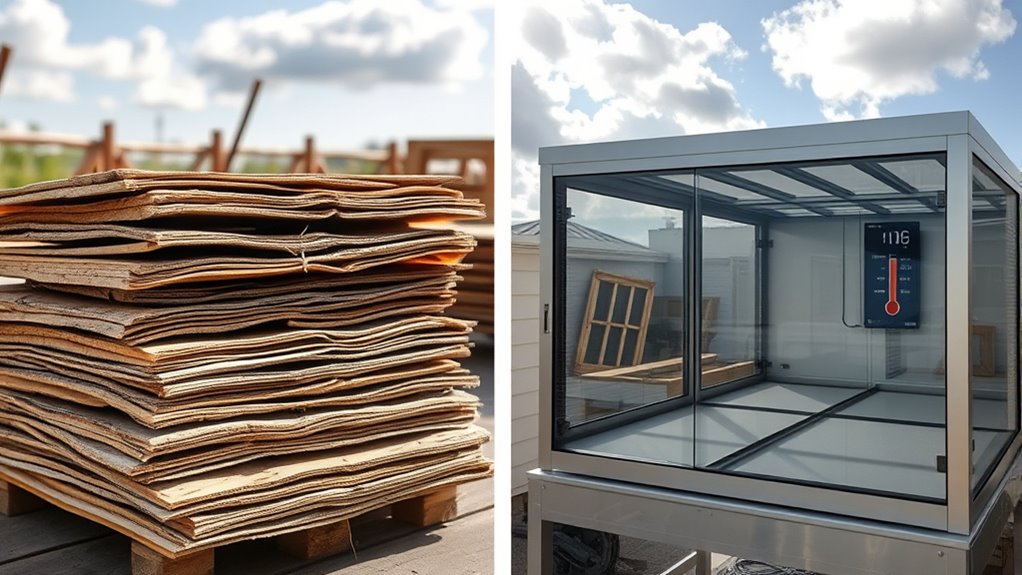
When comparing costs, you’ll notice that initial investments for solar kilns are higher than for simple air-drying setups. Operating costs also differ, with solar kilns often requiring less ongoing energy expenses. Over time, solar kilns can be more cost-efficient, saving you money in the long run despite the upfront investment. Additionally, understanding energy efficiency techniques can help optimize the efficiency of your scoring process, ensuring your investment yields the best possible results. Proper cost management strategies can further enhance the long-term savings associated with solar kiln use. Incorporating sustainable practices can also maximize the environmental and financial benefits of solar kiln technology, especially when integrated with renewable energy sources.
Initial Investment Expenses
While the initial investment for air-drying setups is generally lower, opting for a solar kiln requires a more substantial upfront expense. You’ll need to purchase or build a dedicated structure, including insulated walls, glazing, and a ventilation system. The costs can range considerably based on size and features but typically run several thousand dollars. In some cases, the initial setup cost can be offset by the improved efficiency and higher quality of dried products. In contrast, air-drying relies mainly on basic materials and existing space, making it more affordable initially. However, a solar kiln offers better control over drying conditions, which can justify the higher initial cost for many users. Keep in mind that the investment in a solar kiln also includes equipment like fans, sensors, and temperature controls, adding to the total cost. Additionally, Kia Tuning modifications such as upgraded ventilation systems can further enhance drying efficiency and quality. Your choice hinges on balancing upfront expenses with long-term benefits, especially when considering drying efficiency and the potential for more consistent results. Incorporating temperature regulation into your setup can significantly improve the quality and speed of drying processes, and implementing proper humidity control can further optimize the environment for drying.
Operating Cost Differences
Operating costs differ considerably between air-drying and solar kiln methods. With air-drying, your expenses are minimal since it relies mainly on natural conditions, requiring little energy or equipment. However, you’ll spend more time waiting for the wood to dry, which can increase labor costs and tie up storage space. In contrast, a solar kiln accelerates drying, reducing overall labor time and minimizing the risk of damage. While the initial investment is higher for a solar kiln, your ongoing costs are lower because it uses solar energy, which is free, and requires less manual oversight. Maintenance costs are also typically lower with a solar kiln, as fewer mechanical parts mean fewer repairs. Additionally, tuning enhancements can improve the efficiency of your drying process by optimizing airflow and temperature control. Overall, the operational expenses favor the solar kiln, especially over longer periods.
Long-term Cost Efficiency
Over the long term, the cost efficiency of air-drying versus solar kiln methods can considerably impact your overall investment. Air-drying requires minimal upfront costs but takes longer and depends on weather conditions, which may lead to higher chances of warping or mold, potentially increasing future expenses. Solar kilns, although requiring a larger initial investment, speed up drying times and reduce the risk of defects, saving you money over time. Additionally, solar kilns often need less ongoing maintenance compared to traditional drying methods. By choosing a solar kiln, you may pay more upfront but benefit from lower operational costs, quicker turnaround, and higher-quality wood, ultimately making it a more cost-effective solution in the long run.
Time Required for Drying

The time it takes to dry wood varies considerably between air-drying and solar kiln methods. Environmental factors like humidity and temperature can speed up or slow down the process, affecting your schedule. Knowing the ideal weather conditions helps you choose the best method for timely results.
Drying Duration Differences
Drying duration varies markedly between air-drying and solar kiln methods, impacting how quickly you can process your wood. Air-drying typically takes several months to over a year, depending on wood thickness, climate, and humidity levels. It’s a slower process, requiring patience and proper stacking to avoid warping or cracking. In contrast, a solar kiln accelerates drying considerably, often reducing the process to a few weeks to a couple of months. The controlled environment inside a solar kiln allows for higher temperatures and consistent airflow, speeding up moisture removal. If you need faster results, a solar kiln offers a clear advantage. However, with air-drying, you must plan for extended periods, especially in humid or cooler climates, to ensure proper drying without quality loss.
Environmental Impact on Timing
Environmental conditions heavily influence how long it takes to dry wood, regardless of the method you choose. Factors like humidity, temperature, and airflow directly impact drying speed. High humidity slows moisture loss, prolonging drying time, while warm, dry air accelerates it. Windy conditions increase airflow, speeding up drying, whereas still air can cause delays. Use this table to understand how specific conditions affect drying times:
| Condition | Effect on Drying Time | Recommended Action |
|---|---|---|
| High humidity | Slows drying | Increase airflow or use dehumidifier |
| Warm temperature | Accelerates drying | Maximize sun exposure |
| Low airflow | Slows drying | Improve ventilation |
| Cold weather | Prolongs drying | Use heated or enclosed space |
| Windy days | Speeds drying | Take advantage of natural airflow |
Optimal Weather Conditions
Ideal weather conditions can markedly shorten the time it takes to dry wood. Warm temperatures, low humidity, and good airflow accelerate moisture evaporation. Sunny days with little to no rain are optimal, especially for air-drying, because sunlight helps reduce moisture content and promotes even drying. For solar kilns, consistent warm temperatures and minimal wind fluctuations ensure uniform drying speeds. Avoiding high humidity or sudden temperature drops is vital, as these slow down drying and risk wood defects like warping or cracking. If you can choose when to start drying your wood, aim for periods of stable, warm, and dry weather. Proper weather conditions not only reduce drying time but also improve the quality of the final product.
Quality of Dried Wood

The method you choose for drying wood substantially impacts its final quality. Air-dried wood often develops more natural stability and fewer internal stresses, resulting in fewer warps and cracks if properly monitored over time. However, it may retain more moisture initially, leading to uneven drying and potential surface checks. Solar kiln drying speeds up the process while maintaining better control over temperature and humidity, producing more uniformly dried wood with fewer defects. This method also reduces the risk of internal stresses that cause cracking. Ultimately, the quality of your dried wood depends on careful process management, regardless of method. Properly dried wood enhances durability, appearance, and workability, making it essential to select the technique that best suits your project’s desired quality and timeline.
Environmental Impact and Sustainability
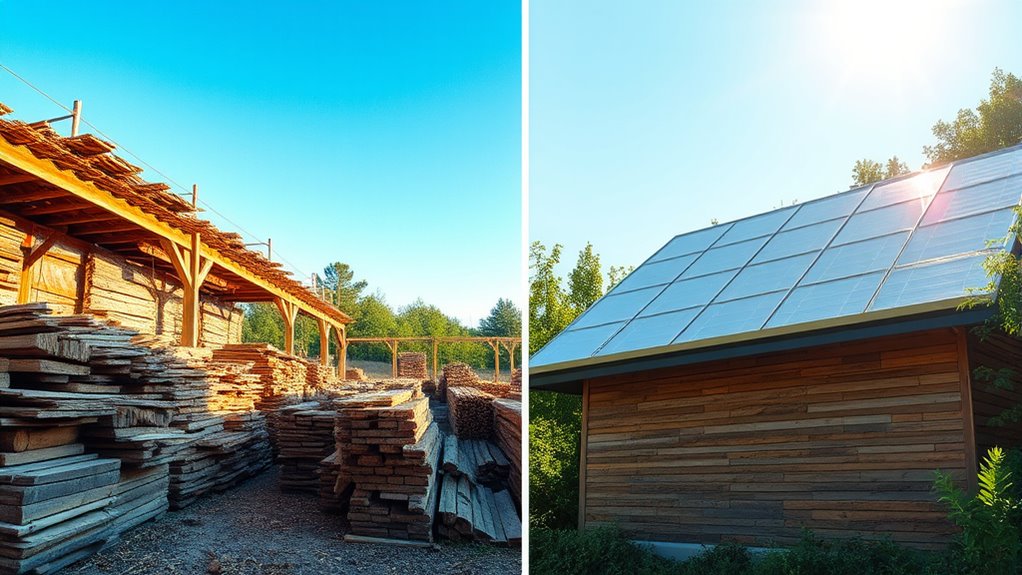
Choosing the right drying method not only affects the quality of your wood but also influences its environmental footprint. Air-drying is generally more sustainable, requiring no energy beyond natural airflow, which minimizes carbon emissions. Solar kilns, while more energy-efficient than traditional kilns, still use some electricity, impacting their overall sustainability.
Consider these points:
- Air-drying consumes no electricity, reducing your carbon footprint.
- Solar kilns harness renewable energy, lowering environmental impact.
- Both methods reduce waste by maximizing wood reuse.
- Using eco-friendly materials in kiln construction can boost sustainability.
- Proper drying techniques prevent defects, extending wood lifespan and reducing resource needs.
Your choice impacts not just your project but the planet’s health as well.
Setup and Maintenance Considerations

Setting up an air-drying space or a solar kiln requires careful planning to guarantee effective and consistent drying. For air drying, choose a well-ventilated, sheltered area away from direct sunlight and moisture. Ensure good airflow by installing vents or fans if needed, and keep the space free of debris. For a solar kiln, you’ll need a sturdy, insulated structure with a transparent cover that maximizes sunlight exposure. Regular maintenance involves checking vents, seals, and the integrity of the covering to prevent moisture ingress. Both methods demand ongoing attention: clean dust and debris from vents, monitor temperature and humidity levels, and repair any damage promptly. Proper setup and maintenance are essential to prevent mold, warping, and other issues that compromise wood quality.
Suitability for Different Types of Wood

Different types of wood respond differently to air-drying and solar kiln methods, so selecting the right approach depends on your specific wood species. Softwoods like pine and cedar dry quickly and tolerate air-drying well, making it ideal for small projects. Hardwoods such as oak and maple take longer and benefit from solar kilns, which speed up drying while controlling humidity. Some woods are prone to warping or cracking if dried improperly, so choosing the correct method is essential. Consider the wood’s density, moisture content, and intended use before deciding.
- Softwoods like pine and cedar are suitable for air-drying
- Dense hardwoods like oak benefit from solar kiln drying
- Moisture-sensitive woods may crack if dried too quickly
- Exotic woods often require controlled kiln environments
- Shrinkage and warping risks vary by species
Risks and Challenges of Each Method

Both air-drying and solar kiln methods come with their own set of risks and challenges that can affect the quality of your wood. Air-drying exposes your wood to weather fluctuations, risking warping, cracking, or mold. It’s slow, and inconsistent humidity levels can cause uneven drying. Solar kilns are faster but can overheat, leading to surface defects or uneven moisture removal. Poor ventilation in either method can trap moisture, promoting decay. Additionally, pests and debris pose threats during outdoor air-drying. Here’s a quick comparison:
| Risk/Challenge | Impact |
|---|---|
| Weather fluctuations | Warping, cracking, mold |
| Overheating in solar kiln | Surface defects, uneven drying |
| Poor ventilation | Moisture retention, decay |
| Pests and debris | Contamination and damage |
Practical Applications and Use Cases

Understanding the risks and challenges of air-drying and solar kiln methods helps you choose the best approach for your needs. These methods have practical applications across various projects. If you’re working on small-scale woodworking or DIY furniture, air-drying offers a low-cost, straightforward solution. For larger quantities or higher quality control, solar kilns provide faster, more consistent results. Farmers and arborists often use solar kilns to process timber efficiently, reducing rot and warping. Hobbyists benefit from solar kilns when drying specialty woods for musical instruments or art pieces. Commercial lumberyards rely on solar kiln systems to meet demand while maintaining quality.
- Small-scale DIY projects
- Large-scale commercial lumber processing
- Specialty wood drying for musical instruments
- Post-harvest timber preservation
- Hobbyist woodworking and art projects
Frequently Asked Questions
Which Method Preserves Wood Color Better?
You want to preserve wood color, so choosing the right method is key. Solar kilns generally do a better job at maintaining color because they control temperature and humidity more effectively, reducing color loss. Air-drying, while slower and more exposed to environmental factors, can cause wood to fade or change color over time. So, if color preservation matters most, a solar kiln is usually the better option for consistent, vibrant results.
Can Both Methods Be Automated for Large-Scale Drying?
You can automate both air-drying and solar kiln methods for large-scale wood drying. Automation involves using sensors, climate control systems, and timers to monitor and adjust temperature, humidity, and airflow. By integrating these technologies, you guarantee consistent conditions, reduce labor, and improve efficiency. While solar kilns are more easily automated due to their controlled environment, advancements also enable automation in air-drying setups for commercial operations.
How Do Humidity Levels Affect Each Drying Process?
Humidity levels play a vital role in drying processes. If humidity is high, your drying will slow down because moisture in the air prevents wood from releasing its own. In low humidity, drying speeds up as moisture escapes more easily. For both methods, controlling humidity guarantees consistent results. You should monitor and adjust humidity levels to optimize drying time and prevent issues like warping or cracking in your wood.
Are There Health Risks Associated With Solar Kiln Use?
Imagine you’re stepping into a solar kiln—think of it as your eco-friendly, futuristic workshop. While solar kilns are generally safe, there are some health risks if you don’t take precautions. You might inhale dust, mold spores, or fumes from treated wood. To stay safe, wear masks, keep good ventilation, and avoid prolonged exposure. Properly maintained, solar kilns are a clean, sustainable way to dry wood without significant health hazards.
Which Method Is More Suitable for Drying Exotic Woods?
When choosing the best drying method for exotic woods, consider your goals and resources. Solar kilns typically dry wood faster and more evenly, reducing the risk of defects. If you want a controlled environment that preserves the wood’s quality, a solar kiln is more suitable. It’s efficient, eco-friendly, and minimizes warping, making it ideal for delicate, expensive exotic woods. You’ll get better results with less chance of damage.
Conclusion
So, whether you choose the slow, predictable air-drying or the high-tech solar kiln, you’re still at the mercy of nature’s whims. Ironically, the cheaper, simpler method might take longer and risk warping, while the solar kiln promises speed and quality but demands a bigger investment. In the end, both methods have their quirks—proof that in woodworking, there’s rarely a perfect shortcut. Choose wisely, and enjoy the unpredictable beauty of your dried wood.
